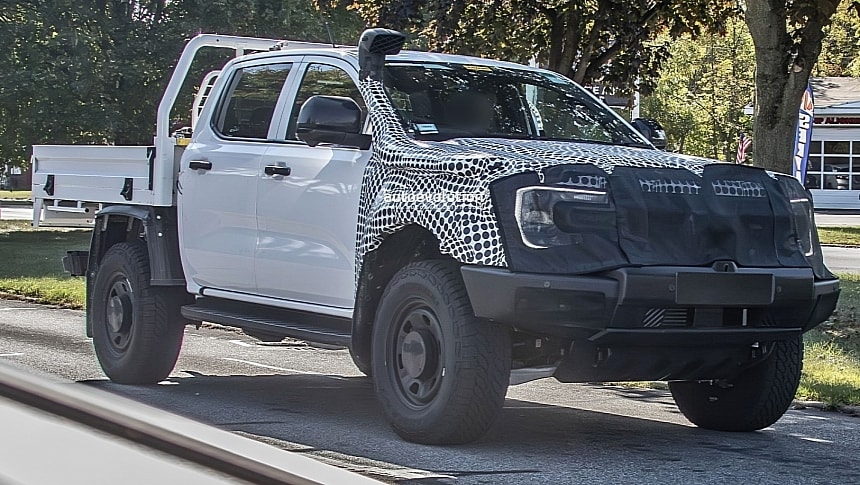The most capable Ranger yet is due in 2026 with the biggest maximum braked towing capacity, gross vehicle mass, and gross combined mass of any Ranger before it. Previewed on November 19, the work-oriented truck has already been spied by the carparazzi with little in the way of camo.
The upper part of the front end, along with the snorkel air intake on the right A-pillar, are camouflaged in white-and-black wrap. Equipped with gloss-black painted side mirrors and black plastic door handles, the mid-size truck further dons a tray instead of a conventional bed. A rear steel bumper with parking sensors, complete with a tow ball, also needs to be mentioned. We also notice a full-size spare wheel under the body-color tray.
Ford's heavily anticipated Ranger Super Duty further sweetens the deal with running boards, General Grabber A/T rubber mounted on black-painted steelies with black hub covers, and pretty serious mudguards for the rear wheels. Parking sensors are featured up front as well. From the looks of it, Ford will also throw in a black-painted front skid plate.
Look even closer, and you'll notice a reworked radiator grille, fender extensions, beefier leaf springs, and what appears to be a beefier differential as well. A close-up shot also reveals LT275/70R18 for the all-terrain boots, which means 33.2 inches. By comparison, the SuperCrew-only Ranger Raptor ships with LT285/70R17 tires, meaning 32.7 inches.
Developed by the Ford Motor Company's Australia-based IMG Product Development team, the Ranger Super Duty is likely powered by a turbo diesel. Which one is – for the time being – not known. This generation of the Ranger comes with either the 2.0-liter EcoBlue I4 or the 3.0-liter Power Stroke V6, with the latter having the bigger punch.
Over in Australia, output figures range from 125 kilowatts and 405 Newton-meters for the single-turbo EcoBlue to 154 kilowatts and 500 Newton-meters for the bi-turbo version, followed by 184 kilowatts and 600 Newton-meters for the range-topping diesel engine. Converted to imperial, make that 247 horses at 3,250 revolutions per minute and 443 pound-feet at 1,750 to 2,250 revolutions per minute for the 3.0-liter Power Stroke V6.
Only the Ranger Raptor's 3.0-liter EcoBoost V6 is punchier, although torque favors the six-cylinder diesel. In addition to the ubiquitous 10-speed automatic developed by Ford in collaboration with General Motors, the Ranger for Australia comes with a sixer as well, but it's exclusive to the entry-level EcoBlue with 125 kilowatts to its name.
The 10R-series transmission has proven itself in many applications, and we're utmost certain the Ranger Super Duty will make use of this 10-speed automatic. In all likelihood, the Dearborn-based automaker will use the 10R80 version, with 80 referencing 800 Newton-meters (590 pound-feet) of input torque.
As for the highlight figures, the 2026 Ford Ranger Super Duty will shame full-size trucks with its towing capacity. Ford is targeting 4,500 kilograms or 9,921 pounds, with the F-150 for Australia rated at the very same 4,500 kilos. The targets for gross vehicle weight and gross combined weight are 4,500 and 8,000 kilos (17,637 pounds).
Ford's heavily anticipated Ranger Super Duty further sweetens the deal with running boards, General Grabber A/T rubber mounted on black-painted steelies with black hub covers, and pretty serious mudguards for the rear wheels. Parking sensors are featured up front as well. From the looks of it, Ford will also throw in a black-painted front skid plate.
Look even closer, and you'll notice a reworked radiator grille, fender extensions, beefier leaf springs, and what appears to be a beefier differential as well. A close-up shot also reveals LT275/70R18 for the all-terrain boots, which means 33.2 inches. By comparison, the SuperCrew-only Ranger Raptor ships with LT285/70R17 tires, meaning 32.7 inches.
Developed by the Ford Motor Company's Australia-based IMG Product Development team, the Ranger Super Duty is likely powered by a turbo diesel. Which one is – for the time being – not known. This generation of the Ranger comes with either the 2.0-liter EcoBlue I4 or the 3.0-liter Power Stroke V6, with the latter having the bigger punch.
Only the Ranger Raptor's 3.0-liter EcoBoost V6 is punchier, although torque favors the six-cylinder diesel. In addition to the ubiquitous 10-speed automatic developed by Ford in collaboration with General Motors, the Ranger for Australia comes with a sixer as well, but it's exclusive to the entry-level EcoBlue with 125 kilowatts to its name.
The 10R-series transmission has proven itself in many applications, and we're utmost certain the Ranger Super Duty will make use of this 10-speed automatic. In all likelihood, the Dearborn-based automaker will use the 10R80 version, with 80 referencing 800 Newton-meters (590 pound-feet) of input torque.
As for the highlight figures, the 2026 Ford Ranger Super Duty will shame full-size trucks with its towing capacity. Ford is targeting 4,500 kilograms or 9,921 pounds, with the F-150 for Australia rated at the very same 4,500 kilos. The targets for gross vehicle weight and gross combined weight are 4,500 and 8,000 kilos (17,637 pounds).
























